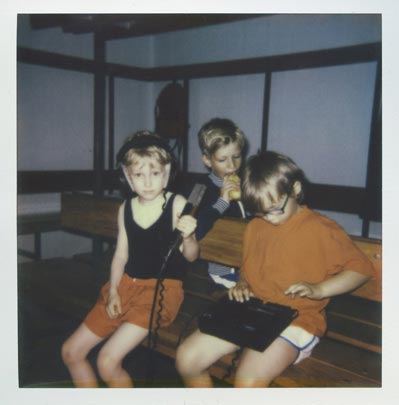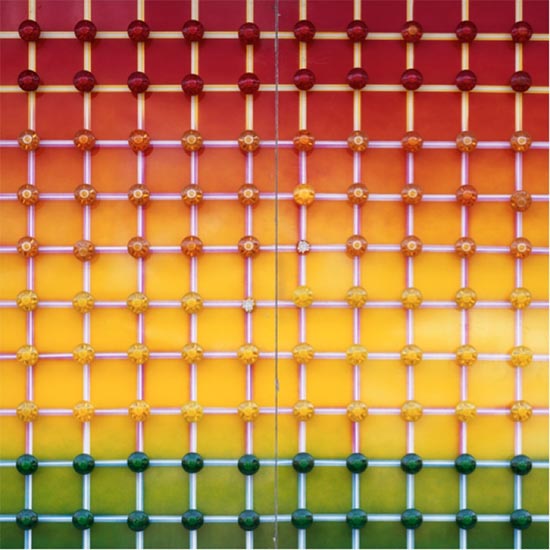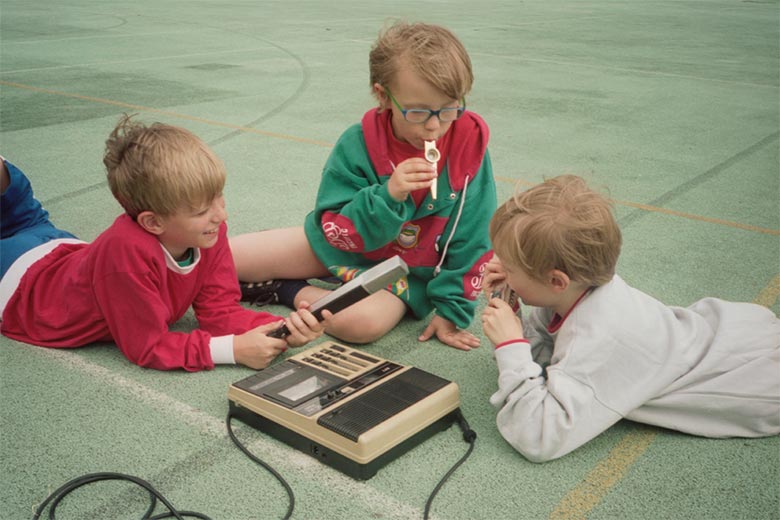
Discovering Everything
After decades of hiatus from the collaborative musical project of their youth, Gmeiner talks about the origin of his practically life-long musical partnership with composer Frahm and Singwald as if it wasn’t far out of the ordinary. Perhaps he’s partly right.
“We started as many kids in the ’80s did, with having our own cassette recorders. Our parents, like many fathers did in the ’80s, had hi-fi equipment, but the children, of course, weren’t allowed to touch that at all,” he explains.
Young Gmeiner was given a simple cassette recorder to keep him away from the more expensive stuff. The same compromise was reached in the Frahm and Singwald households, where the boys independently discovered a fondness for recording anything and everything. They taped music off the radio, and even began to assemble their own productions, which incorporated, among other things, field recordings from their school playground and classrooms.
Singwald came into the picture via a school athletics exchange program in 1989. The three immediately bonded over the tape recorders they carried around everywhere, and remained friends even after Singwald went home. They didn’t come up with the name Nonkeen until much later (“earlier we had a different name, or not a name at all”), but a lasting connection had formed early on.
 By the mid-’90s, twelve-year-olds Gmeiner and Frahm had already begun playing in bands – and as Nonkeen (or, what they were called before they decided on the name), they would put on shows together, which contained an element of their own “small songs”. Open to a wide spectrum of influences, they played “whatever came into our minds”, though Gmeiner recalls that it was “mostly cover songs, of course.”
By the mid-’90s, twelve-year-olds Gmeiner and Frahm had already begun playing in bands – and as Nonkeen (or, what they were called before they decided on the name), they would put on shows together, which contained an element of their own “small songs”. Open to a wide spectrum of influences, they played “whatever came into our minds”, though Gmeiner recalls that it was “mostly cover songs, of course.”
“It could be a jazzy thing; it could be a more rock or minimalist thing, or electro, or a little bit more like drum n’ bass or trip-hop. Everything we liked or listened to, we tried to play,” he says.
When they began to work in the studio, they discovered how to make music with a computer, and were quite inspired at certain times by experimental music like Chick Corea and Soft Machine.
“Our first tryouts were not directly imitating, but a little bit of getting the inspiration from music we liked – trying to re-do it at first, but then continuing and finding our own sound,” notes Gmeiner,
and not just being satisfied [to listen to the] recordings and think, ‘Oh hey, that sounds like’…'”
Stretching Eternally
Keeping in mind the differences between Germany in the ’80s and ’90s and life in present-day America (or Germany, for that matter), such precocious musical influences (jazz fusion, progressive rock) and pursuits must have made Gmeiner, Frahm, and Singwald stand out amongst their peers. Though their approach to creating music has surely been shaped by the experiences they have accumulated over the decades, their 2016 full-length, The Gamble, is a bridge between their past and present selves, and the early characteristics that Gmeiner describes are audible among its layers.
The Gamble is unique in both conception and execution. Its rhythms and patterns elude easy classification. Fans of Nils Frahm’s solo work might at first hear Nonkeen as a kind of jam band, which in a sense wouldn’t be far off. The performances on the album’s nine tracks (ten if you get it on vinyl) are the result of the three recording their improvised rehearsals. That is just one dimension of the album, however, and, if there ever was one, The Gamble is a four-dimensional record, as unbound by time as it is by traditional form.
Even after repeated listens, songs never seem to begin or end on
Their sound today is a direct result of their initial documentary practices. The tapes on which they built the songs were of former group recordings that date back eight years or more. As young teenagers, they found their voice by recording their rehearsal sessions and listening back to them.
“The moments where it didn’t sound so much like anything we already knew, these… were interesting for us somehow; these caught our attention,” says Gmeiner, who also notes that the tools they were limited to also factored in. “We were bound to our instruments, which were Fender Rhodes piano, synthesizer for Nils, electric bass for Sebastian, and drums for me, so we had a certain kind of sound already given by these instruments.”
Making Room
Nonkeen began with plenty of time in recording sessions, but Gmeiner states that they became more focused on playing live together. Yet not long after they started playing out, an unfortunate accident at the Plänterwald fairground where they were performing – in which two children, both who survived, were thrown from a carousel onto the stage — led the three to hang up their collaboration at the age of only fifteen.
“The fairground story… that’s something for itself somehow. [It] is more like a metaphor, or the prototype accident for all of the accidents we had during our time playing together,” says Gmeiner. “For example, Sepp just cut his finger half a year ago, his thumb, with a big saw, and wasn’t sure if he could ever play again on stage live… those are the kind of things which happen all the time, but we can luckily overcome them and still play together.”
Gmeiner, Frahm, and Singwald were all living in Berlin when they decided to once more make music as a trio. Before that, all had been focused on their own work. Frahm, of course, has concentrated on his extensive solo career. Singwald is by trade an electrical engineer, and also has other musical side projects, including one with Gmeiner. Gmeiner himself matched his fascination in audio equipment with his fascination with video equipment, and co-founded the design studio FELD.
“When I was really young and [people asked,] ‘What profession do you want to have later?’, I always said ‘camera man,'” he recalls.
Meandering Audio-Visual Roads
The nature of man’s relationship to machines is part of the theme for “Chasing God Through Palmyra”, the music video Nonkeen made with the help of Gmeiner’s Berlin design studio, FELD. FELD has worked plenty with the experimental label Erased Tapes, and has also helped build a pipe organ for Frahm, but they infrequently work on music videos. This video takes a fascinating and sometimes dizzying first-person trip along a model train track courtesy of Berlin’s Mectub Railway Club.
Gmeiner is quick to point out that no one in the trio has a model train hobby — but “this passion for recreating the reality with so many details on the model scale, often in the basement hidden from the public, was really interesting for us.”
Much like their music, Nonkeen didn’t have much of a concept in place when they began work on the video; they simply followed their curiosities. and got the contacts of model train builders, who were very keen on collaborating. Slowly, Nonkeen began to understand their work of train enthusiasts and what interests them about it, and were surprised to find that there were some parallels to the way they worked and what Nonkeen value about their music.
Part of the goal with “Chasing God Through Palmyra” was to see if they could make a video in a physical domain, without falling back on CGI, where the viewer sometimes doesn’t know if it is real or a model.
“Building a railway is already something artificial, then having everything smaller scale, even, it’s kind of double-artificial,” Gmeiner says, expanding on the relationship between man and machine. “But, in the same way, it’s not; it’s just a model in the end.”
For Nonkeen’s reunion, the three started by getting together sometimes twice a week – and sometimes not for a couple months, depending on whether or not everyone was in town. “It was really about fun,” Gmeiner says, “and also finding room.”
Thinking about what it was like to get back in a room to play together, Gmeiner notes feeling the same kind of connection they had before. There was a kind of magic about it, and they didn’t have to talk that much about the music.
“Of course – now, since we released the album, we have to talk a lot about our music,” he laughs, “but that’s fun because before we never really had to.”
Processing Raw Material
In addition to discussing their music with the outside world for the first time, Nonkeen are also preparing for their first tour, which will take them around Europe. Gmeiner is enjoying it all, but notes, “We really have to see if it will change something with the band or with the process as well, and if we can maintain this spontaneous approach.”
As spontaneous as it is in one way, Nonkeen’s process is also thorough, multi-layered, and vulnerable to varying conditions. The recordings of their improvised sessions are often subject to the whims of their tape machines, which Gmeiner describes as having “their own little life and character.” If a jack isn’t plugged in, cables are broken, or the tape speed is set wrong, it can have an effect on the outcome – but not necessarily in a negative way.
 “Sometimes someone puts in a tape through the wrong direction, for example, and stuff you wouldn’t consider interesting immediately sounds interesting. Or one channel is completely distorted — of the bass, for example — and we can’t use it, but maybe without the bass it sounds much better, and we get other ideas how to continue with it,” says Gmeiner. “For The Gamble, maybe 1% of the material we recorded during the last eight years was considered a candidate. Two years ago, we had the idea of trying to make an album of that material.”
“Sometimes someone puts in a tape through the wrong direction, for example, and stuff you wouldn’t consider interesting immediately sounds interesting. Or one channel is completely distorted — of the bass, for example — and we can’t use it, but maybe without the bass it sounds much better, and we get other ideas how to continue with it,” says Gmeiner. “For The Gamble, maybe 1% of the material we recorded during the last eight years was considered a candidate. Two years ago, we had the idea of trying to make an album of that material.”
Listening back to their tapes intermittently — as weeks would sometimes pass between band meetings — they would come across material they didn’t even remember playing. This meant that parts couldn’t be re-recorded to get better takes; they had to be accepted or rejected as they were. At various points in between adding and deleting individual instrument tracks, they would also make mix-downs of what they had for a given song with the intention of making it so that they couldn’t go back and undo every step. In this way, they kept themselves from spending too much time behind a computer, distanced from editing and polishing everything to perfection. Gmeiner considers every song on The Gamble (and others they finished that didn’t make the cut) to be unique, rather than an extension of some previous version recorded years ago.
“There are some themes that we kept playing over and over,” he recalls, “but after a while, we were bored by that, and none of those themes made it to the album.”
For Gmeiner, knowing what to play and what to expect makes the trio’s music feel stiff and not as lively. The joy comes in not really knowing what the next bar will sound like.
“The good thing for us was that we were always surprising ourselves, and that no one had the feeling that someone was writing the songs, or someone was doing more than the others. I mean, each one of us also has his own professional field where of course he knows a little bit more than the others, and is more skilled,” Gmeiner explains. “But, in a way, that was balanced out very nicely, so we never had those typical band moments where someone is writing the songs, and this person often has more influence on the arrangements and decisions and everything.”
“I think the reason why we didn’t play in so many other bands was exactly that,” he continues. “[Nonkeen] was quite democratic in a way, but without discussing that much, so that was quite relieving.”
Clement Attlee, who was Prime Minister of the UK in between terms served by Winston Churchill, was once quoted as saying that “Democracy means government by discussion, but it is only effective if you can stop people talking.” Depending on how one interprets Attlee, the way Nonkeen operates could be a fine example of that idea in action.
Many bands like to say they are fully equal partnerships, but Nonkeen are a rare example where that is actually the case. This shapes The Gamble‘s distinct character, its seamless accumulation of years of shared musical ideas, and even more years of shared creative vision.

Ω






